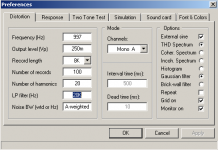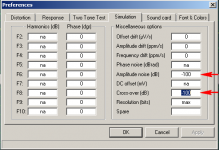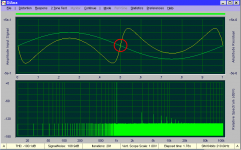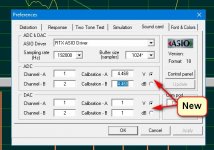The new version loaded and came right up. Works without issues. System is aware and I added a link by pinning the icon to the task bar.
Can you explain the numbers next to the marker/cursor? Frequency I get frequency but the other two numbers I don't.
What is the phase relationship between the reconstructed residual waveform and the fundamental Especially higher harmonics. it can be really useful to determine what part of the cycle is distressed to know where to look.
Can you explain the numbers next to the marker/cursor? Frequency I get frequency but the other two numbers I don't.
What is the phase relationship between the reconstructed residual waveform and the fundamental Especially higher harmonics. it can be really useful to determine what part of the cycle is distressed to know where to look.
Configuration files
An old ini file is only deleted when it is heavily corrupted, i.e. when a parameter is missing for example. If a parameter is manually altered, a CRC error is reported, which can be overruled by pressing the "Proceed" button and the cal. constants will be preserved. However, if the "Use defaults" button is clicked, the cal. constants will be replaced by 1, of course. In the latter two cases, the old ini file is not deleted (only possibly altered).
> "simple spreadsheet": Oh No! On your request, I've just made provisions to save the ini file under a different name, see post 421. The the cal. constants can be found under: ADC1Calib=1, ADC2Calib=1, DAC1Calib=1 and DAC2Calib=1. In this case default values are shown. Note: These configuration files will never be deleted by DiAna.
Cheers, E.
Hi Demian,The problem in deleting the old .ini file is saving the cal constants. I just use a screen snip to save them but they should be recorded. Maybe the ideal would be a simple spreadsheet to calculate the correction based on measured output from a known source.
An old ini file is only deleted when it is heavily corrupted, i.e. when a parameter is missing for example. If a parameter is manually altered, a CRC error is reported, which can be overruled by pressing the "Proceed" button and the cal. constants will be preserved. However, if the "Use defaults" button is clicked, the cal. constants will be replaced by 1, of course. In the latter two cases, the old ini file is not deleted (only possibly altered).
> "simple spreadsheet": Oh No! On your request, I've just made provisions to save the ini file under a different name, see post 421. The the cal. constants can be found under: ADC1Calib=1, ADC2Calib=1, DAC1Calib=1 and DAC2Calib=1. In this case default values are shown. Note: These configuration files will never be deleted by DiAna.
Cheers, E.
Phase relationship
Hi Demian,
These are the abscissa of the screen and the index to the FHT array. In the past, I used them for debugging. They can be deleted by now. So just ignore these numbers.

Cross-over distortion, for example, is easily detected by means of the residual, see simulated picture below (which also shows a correct phase relationship).
BTW, are SNR figures better now?
Cheers, E.
PS: The phase of the 3rd harmonic is -179.98 degrees, so almost correct.
Hi Demian,
Good to hear.The new version loaded and came right up. Works without issues. System is aware and I added a link by pinning the icon to the task bar.
I assume you mean the numbers at the bottom of the marker next to x: and i:Can you explain the numbers next to the marker/cursor? Frequency I get frequency but the other two numbers I don't.
These are the abscissa of the screen and the index to the FHT array. In the past, I used them for debugging. They can be deleted by now. So just ignore these numbers.
The phase relationship is undistorted, or at least, it should be. Basically, the residual waveform is not a reconstruction, as it is obtained by subtracting an ideal sine from the input signal directly. So the phase error should be zero. But in a sense, a reconstruction takes place when the residual is filtered, which is done by means of an FHT, followed by an inverse FHT. Filter characteristics can be specified in the Distortion menu under LP Filter (Hz), Gaussian filter and Brick-wall filter.What is the phase relationship between the reconstructed residual waveform and the fundamental Especially higher harmonics.
Sure! And that was one of the main reasons to start this project anyhow.it can be really useful to determine what part of the cycle is distressed to know where to look.
Cross-over distortion, for example, is easily detected by means of the residual, see simulated picture below (which also shows a correct phase relationship).
BTW, are SNR figures better now?
Cheers, E.
PS: The phase of the 3rd harmonic is -179.98 degrees, so almost correct.
Attachments
Last edited:
Calibration factor
Hi Manolis,
At the moment, it's still Vp and the relation is simply dB = 20*log10(Vp).
The only new thing is that you also can enter the cal. factor in dB.
In the next version however, these values will be interpreted as RMS and, to avoid confusion, you will see "Vrms" respectively "dBV" in the menu.
How about your PC and OS? Is it fast enough?
Cheers, E.
Hi Edmond,
Just I download the new 1.48.9 version.
I see a new calibration or it is something else?
The V is Vp still or Vrms?
What is relation of "dB"?
Hi Manolis,
At the moment, it's still Vp and the relation is simply dB = 20*log10(Vp).
The only new thing is that you also can enter the cal. factor in dB.
In the next version however, these values will be interpreted as RMS and, to avoid confusion, you will see "Vrms" respectively "dBV" in the menu.
How about your PC and OS? Is it fast enough?
Cheers, E.
The problem in deleting the old .ini file is saving the cal constants. I just use a screen snip to save them but they should be recorded. Maybe the ideal would be a simple spreadsheet to calculate the correction based on measured output from a known source.
Hi Demian,
In the next version, I will revert back to the procedure from earlier versions. So instead of deleting the old ini file, it will be renamed with a .bak extension.
Cheers, E.
Hi Demian,
In the next version, I will revert back to the procedure from earlier versions. So instead of deleting the old ini file, it will be renamed with a .bak extension.
Cheers, E.
Edmond, is it not possible to xor the various entities in the two .ini files to keep the good old ones?
I realize I may know just enough about this to be dangerous ;-)
Jan
PS: Above procedure only applies to the regular ini file, thus not configuration files that are saved under different names (by using Save configuration in the file menu). These files are first deleted and replace by a fresh one. The reason why they are not simply overwritten is because possible old rubbish will not be removed.
Cheers, E.
Cheers, E.
Edmond, is it not possible to xor the various entities in the two .ini files to keep the good old ones?
I realize I may know just enough about this to be dangerous ;-)
Jan
Hi Jan,
Theoretically, that would certainly be possible, but wouldn't that be a hell of a job, as there are 255 variables! Each of them has to be checked separately whether it is a "good one" or not. Is it worth all the effort? Besides, we are dealing here with a temporary problem, as with each upgrade the content of the ini-file (number and kind of variables) may be different. When the program has been finally stabilized, a corrupted ini-file is far less of a concern.
Cheers, E.
Wine
Hi Mogens,
Cheers, E.
Hi Mogens,
Thank you!Hi Edmond,
[...]
Btw. Looks to be a nice piece of software
In the past, I was reluctant to use Linux, as Windows fulfilled all my needs. But nowadays, as Windows becomes more like a cell-phone OS to let people chat via social media (okay, I'm exaggerating a little bit), I reconsider to switch to Linux and use Wine to run DiAna. But how about the the ASIO drivers that were only targeted to Windows? Are there emulators or so available to make it work?However, even though I have been a Windows user for many years, I switched to Linux 5 years ago, as work situation required it. Never looked back. As a developer it fits my needs much better. But, I will get my WIN10 machine dusted
Cheers,
Mogens
Cheers, E.
Corrupted configuration file
What exactly it might cause a corrupted ini-file is hard to say, as to me it happened only a few times during all those years. Perhaps the variable area was overwritten due to a bug. But there are few other causes:
1. Using an old ini file to configure a new version of DiAna. If a new item is missing, an error message will be shown. If the old ini-file contains an obsolete item, this will be undetected and no error is reported. However, I prefer to delete obsolete stuff anyhow, simply by deleting the old file when installing a new version of the program.
2. Entering an invalid parameter, that slips through controls.
Cheers, E.
Hi David,Edmond I remember back in the days of no registry a corrupted ini file was quite common for win apps. What exactly causes an ini file to become corrupted?
What exactly it might cause a corrupted ini-file is hard to say, as to me it happened only a few times during all those years. Perhaps the variable area was overwritten due to a bug. But there are few other causes:
1. Using an old ini file to configure a new version of DiAna. If a new item is missing, an error message will be shown. If the old ini-file contains an obsolete item, this will be undetected and no error is reported. However, I prefer to delete obsolete stuff anyhow, simply by deleting the old file when installing a new version of the program.
2. Entering an invalid parameter, that slips through controls.
Cheers, E.
ALSA
To make use of ALSA, does it mean I have to rewrite completely the interface to ASIO drivers? If so, I'm afraid I'm too old for that.
Cheers, E.
PS: I'm working on the RMS issue.
Hi Demian,The native Linux sound system works better than Windows once you understand ALSA. I could make use of both. However maintaining both may be more than you want to do.
To make use of ALSA, does it mean I have to rewrite completely the interface to ASIO drivers? If so, I'm afraid I'm too old for that.

Cheers, E.
PS: I'm working on the RMS issue.
WINEASIO
Cheers, E.
Thank you for the hint.What are your thoughts on OSS? Does it have real advantages or is it not really any better than ALSA in principle?
For Linux there is WINEASIO. I'm not a programmer, so I failed to compile it, but it probably works fine.
Cheers, E.
- Home
- Design & Build
- Equipment & Tools
- DiAna, a software Distortion Analyzer



